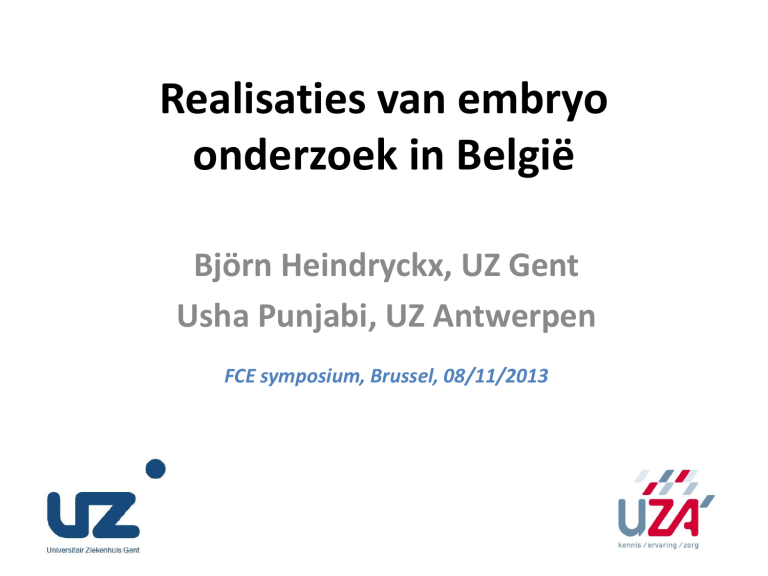
Realisaties van embryo
onderzoek in België
Björn Heindryckx, UZ Gent
Usha Punjabi, UZ Antwerpen
FCE symposium, Brussel, 08/11/2013
Belgium: research on embryos: law since 11
May 2003
Federal Commission for medical and scientific
research on Embryo’s in vitro (FCE) established
and functional since 6 juni 2006
Projects 2003 - 2006
Information was collected from all IVF centres
regarding research carried out on embryo’s in
vitro between 2003 – 2006
No advice on these research projects by FCE
Broad areas of research carried out for
projects 2003 – 2006 (n= 29)
embryo implantation
6,9%
embryo treatment
ovarium biopsies
6,9%
6,9%
culture conditions
stem cells
6,9%
20,7%
cryopreservation
6,9%
17,2%
oocyte maturation/
activation
27,6%
genetic diagnosis
Projects 2006 - 2012
Between 2006 – 2012 a total of 47 projects
were submitted and discussed
3/47: continuations
Submitted proposals mainly from University
centres:
UZB: 15
UZG: 11
UZL: 13
ULB: 5
UZA: 3
ULG: 1
Remarks: - 1 study multicentric (3)
- 1 application from non-University IVF centre
47 projects submitted 2006-2012
35
70%
30
25
20
Reeks1
15
19%
10
8.5%
5
0
Positive
Negative
Not applicable
Audit
Negative evaluation
4 projects:
– Lack of scientific motivation (2)
– Inappropriate IC (1)
– Lack of local EC approval/non-university setting (1)
Remark: only 1 was resubmitted and approved
Audit: no local EC approval/study started
Embryo Law: not applicable
9 projects:
– Using established and published protocols
according to ESHRE guidelines
– For example:
• Slow freezing vs. vitrification
• Day 2 vs. day 5 transfer
• Comparing culture media
Remark: Endpoint always pregnancies
Positive approval: 2006 – 2012 (n= 33)
Cell Stem Cell, 2011:
-Class 1: human development
-Class 2: embryonic stem cells
Type of embryos
2006-2007: mostly no estimation of embryos to be used
2008: estimation necessary
2009: estimation necessary (2 categories: created vs.
supernumerary)
2010: estimation necessary according to 4 categories:
Type of applied embryos
Fresh supernumerary: inferior quality: not for embryo
transfer or freezing
Frozen supernumerary: good quality: childwish
completed
Created embryos: for specific research goals allowed
Research projects 2006 – 2012:
type & number of embryos applied
12000
10000
8000
6000
4000
2000
0
Fresh supernumery
Frozen supernumary
Fresh created for
research
Frozen created for
research
Others
Type of applied embryos
Belgium situation (2006-2012)
HFEA (2005-2006)
Fresh supernumerary
68%
70.0%
Frozen supernumerary
13%
25.0%
Fresh created
18%
5.0%
Type of embryos
Fresh
Supernumerary
(n)
(% of total)
Frozen
Supernumerary
(n)
(% of total)
Created (n)
(% of total)
Others (n)
(% of total)
% of total
embryos
ESC
6000 (58)
1139 (58)
340 (12)
0 (0)
49%
Culture
Conditions
1580 (15)
0 (0)
0(0)
0 (0)
10%
IVM
0 (0)
0 (0)
680 (25)
0 (0)
4%
Genetic
Analysis
1635 (16)
380 (19)
200 (7)
0 (0)
15%
Activation/
embryo
dev.
430 (4)
230 (12)
1000 (37)
0 (0)
11%
Cryo
690 (7)
210 (11)
522 (19)
266 (100)
11%
Research projects 2006 – 2012:
applied vs. effectively used (n=13)
3500
3000
2500
2000
Applied
Used
1500
1000
55%
500
27%
0
Fresh supernumerary Frozen supernumary
Fresh created for
research
Frozen created for
research
Others
Type of embryos
Worldwide availability of embryos / willingness to
donate for research: not easy to map
USA (2003): 400.000 embryos frozen:
only 11.000 designated for research (3%)
Belgium:30,043 embryo’s frozen
788 designated for research (26.2%)
Belgium
Veerle Provoost:
Research projects 2006 – 2012
scientific work follow-up (n=13)
16
14
12
10
8
6
4
posters
oral communications
publications
master thesis
A13
A12
A11
A10
A9
A8
A7
A6
A5
A4
A3
A2
0
A1
2
submitted papers
Conclusions
FCE only decides over embryo research related
to ‘experimental & investigational procedures’
High approval rate
Obligated approval from FCE did not change
~60% for ESC
focus of research subjects
research
Types of embryos:
Mostly fresh supernumerary embryos
Less frozen supernumerary embryos (reasons?)
More created embryos (reasons?)
Overestimation of some categories
Conclusions
Big differences in scientific output (still a lot
ongoing….)
Better follow-up necessary of scientific output:
Longer (publications take time)
Check content of the papers (related to proposal?)
Discussion warranted in the FCE about the final
report
Give feedback to reseachers?












